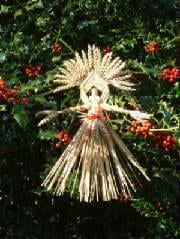Earlier this week a task was set before me, to create a short performance from a set of stimuli taken from the gallery. One of the stimuli I was given was a picture of a corn dolly, an ancient pagan tradition where straw from the last corn crop of the year are bound in such a way to resemble a doll. It was believed that a spirit of the harvest would make its home in the doll. The doll is then buried along with the first seed sown from the new crop, with the pagans believing this would guarantee a good harvest. Corn dolls are still created in the modern age, although it is more for the preservation of an old craft. This had me thinking about tradition and ritual, and how it has changed in the modern age. The past is preserved in museums, although it is not authentic. Museums preserve the knowledge of rituals, though it is arguable that the ritual itself is found more in theatre. I am excited to see how the marriage of museum and performance can vivify ritualistic processes.
(Image credit: http://www.corndollies.co.uk/)
The performance I derived from this was inspired by the thought of modernising such a ritual. There are many rituals nowadays. When an athlete performs a set of actions before every game, or an actor eats the same meal before every opening night, it is a ritual. Yet this corn dolly ritual would be seen as ridiculous in our age.
The text I prepared for my performance was as follows,
“Firstly would have to shred numerous five pound notes (real or printed, depending on disposable income), then would weave and plat these monetary strips into traditional pagan style corn dolls. Once the desired number of dollies has been reached, they will be placed in appropriate locations. If they are to be buried, as traditional straw dolls were to ensure a bountiful harvest, they should be contained in little plastic bags before burial to prevent destruction. Once the “Dolla’ Dolls” have been assembled, spirits of finance should live within them. Burying the inhabited doll should guarantee strong financial gain in the year to come. It is best to bury these dolls in a varied number of locations, and have at least three areas where money is abundant, such as a bank. If all of these procedures are followed exactly, then be prepared for an influx of capital to your life”
An ancient pagan ritual adapted for modern western society.
This ritual may now seem stupid, and of course it is. The stupidity of this act primarily comes from potentially destroying your own money for the chance to gain some more. However, the desire to carry out inane tasks, for the promise of gain, is still abundant in our culture; you simply have to browse social media websites to see countless “like this post to win a million” or “share this and you will be famous”
Nonsensical actions are alive and well today, and so is ritualism, they have simply lost their theatricality…

Recent Comments